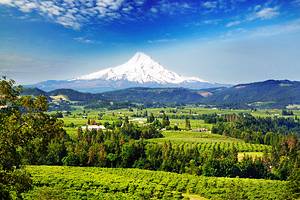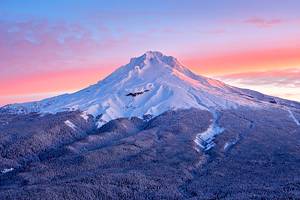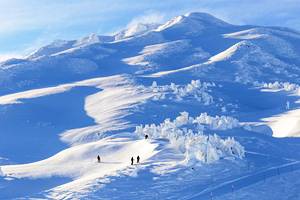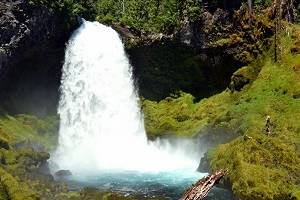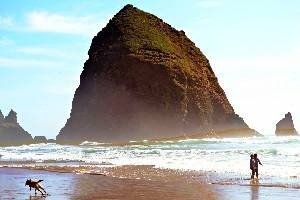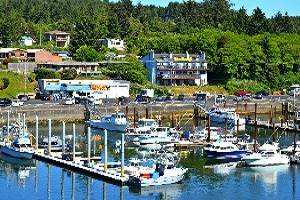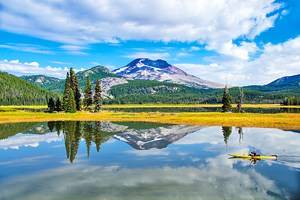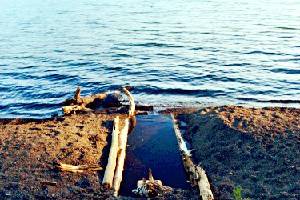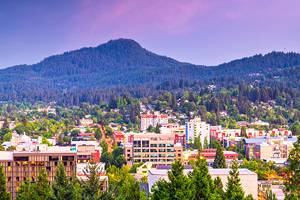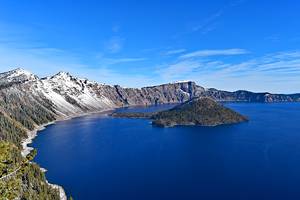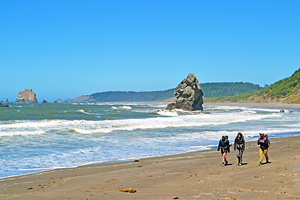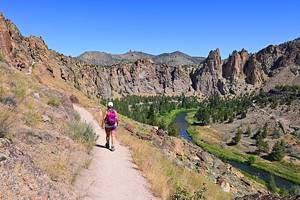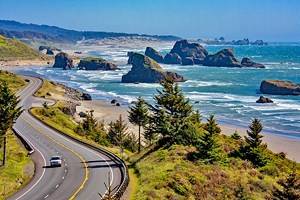Hiking Trails in Oregon
Waterfalls, calderas, hot springs, and historic mansions are just a few of the eye-catching sights on Oregon's best hiking trails. From the rugged coastline to glaciated peaks, these prime hiking destinations attract millions of tourists each year. And areas of interest like Eagle Creek and the McKenzie River are well known throughout the country.
Alongside a variety of scenic places to visit, the best hikes in Oregon cater to a wide range of hikers. From family hikes to strenuous day hikes and overnight adventures, abundant trailheads dot the Oregon countryside. Also among the top things to do in Oregon are waterfall hikes, city hikes, and state-spanning backpacking routes.
Hiking through history is possible on the traverse of the coastal Tillamook Head, and tackling the Wildwood Trail is one of the top things to do in Portland, with cultural attractions surrounding all 30 miles of it.
Families will enjoy the Trail of Ten Falls just outside Salem, and anyone looking for a longer adventure can find it on every mile of the Pacific Crest Trail, which stretches throughout the state. Equipped with the proper gear and an understanding of the environment, hikers will be astounded by the beauty of the state's trails. Learn more about them with our list of the best hiking trails in Oregon.
- Trail of Ten Falls, Silver Falls State Park
- Tillamook Head Traverse, Seaside & Cannon Beach
- Wildwood Trail, Portland
- Discovery Point, Crater Lake National Park
- Eagle Creek Trail, Columbia River Gorge
- Misery Ridge, Smith Rock State Park
- Bagby Hot Springs Trail
- Angel's Rest Trail, Columbia River Gorge
- McKenzie River Trail, Willamette National Forest
- Paulina Lake Trail, Newberry National Volcanic Monument
- Timberline Trail
- Oregon Coast Trail
- Pacific Crest Trail
- Map of Hiking Trails in Oregon
Trail of Ten Falls, Silver Falls State Park
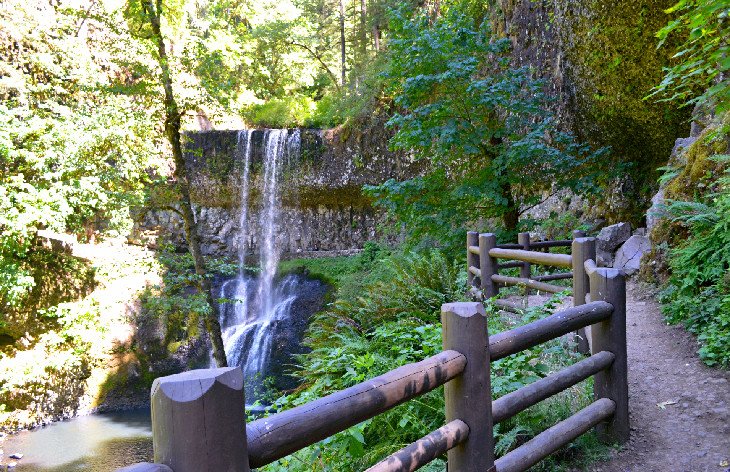
This waterfall-infused state park is a 30-minute drive from the State Capitol in Salem. As well as being one of the most popular state parks, it is also Oregon's largest state park and is home to one of Oregon's best campgrounds. For many of these reasons, Silver Falls is also known as the "Crown Jewel" of the state park system.
What really makes Silver Falls stand out is the aptly named Trail of Ten Falls within its boundaries. This National Recreation Trail is an approximately seven-mile loop and a moving showcase of water and family attractions.
Side trails on the route allow shorter trips to accommodate all members of a hiking party. Most treks on the trail begin at the South Falls day-use area, where the trail traverses behind the impressive 177-foot South Falls.
The trail is a moderate grade from there, with a few steep climbs aided by handrails. The entire loop passes by at least ten more waterfalls in total, many outshining the last, with five falls over 100 feet in length. On any warm day throughout the year, expect to share the waterfall mist with other interested observers.
Tillamook Head Traverse, Seaside & Cannon Beach
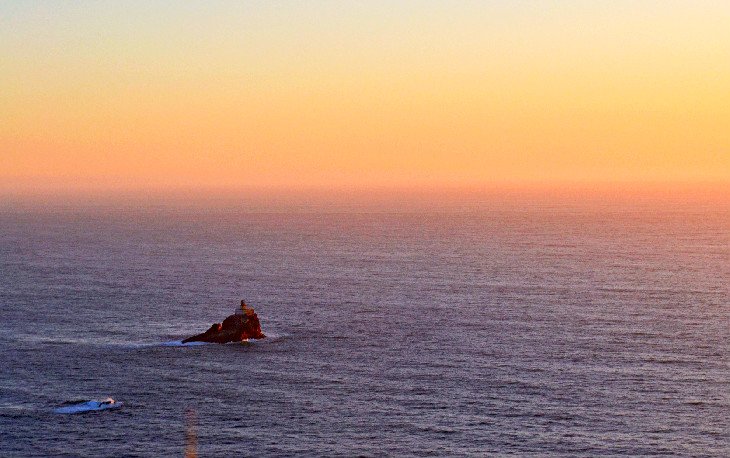
The traverse across Tillamook Head follows the footsteps of Lewis and Clark up and into a lush coastal forest environment. Members of the Corps of Discovery made this similar trek on the Oregon coast, searching for whale blubber and winter supplies. The trail today is part of Ecola State Park and much easier to follow.
The route across Tillamook Head spans between Seaside to the north and Cannon Beach to the south. The hike begins either at Indian Beach adjacent to Cannon Beach or by the recommended approach of taking a Seaside Streetcar to the North Tillamook Head trailhead. It's an uphill endeavor either way, but the manageable ascent is well worth the effort.
From the North Tillamook Head trailhead, it's a four-mile hike to the top and another 2.5 to reach Indian Beach. A free backpacker's campground with three Adirondack shelters and a large firepit awaits hikers who haul their gear to the top.
Day hikers have reasons to stop at the backpacker's camp, too, and a short spur trail leads to an ocean overlook of the offshore Tillamook Rock Lighthouse – a particularly stunning sight come sunset.
Hikers can either coordinate a shuttle to traverse the whole trail in a day or make it an out-and-back journey by turning around at the top.
Wildwood Trail, Portland
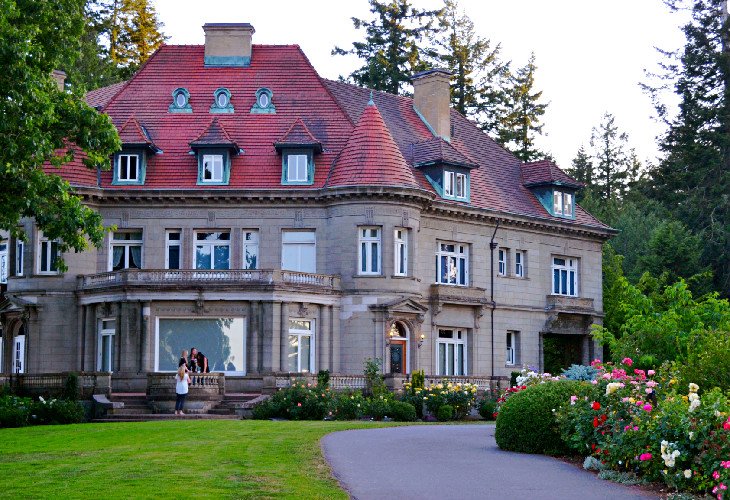
The Wildwood Trail is a National Scenic Trail and connector for many of Portland's best hiking trails. The trail stretches for over 30 miles and offers an easy escape from the city.
Beginning at the Vietnam Memorial near the Oregon Zoo and Hoyt Arboretum, the Wildwood Trail passes through significant portions of Washington Park to start the trek. Other iconic Portland destinations, including the International Rose Test Garden and Pittock Mansion, offer worthy detours within the trails' first five miles.
After passing these significant landmarks, the trail becomes less populated the farther you go, especially as it enters the expansive Forest Park. Multiple access points and trail junctions enable easy section hiking of this designated National Scenic Trail. Several trails also bisect Wildwood, making it recommended to download or bring a map before exploring.
Discovery Point, Crater Lake National Park

Over 175 miles of trails wind throughout Crater Lake National Park. And the most traversed trail in the park is a two-mile stretch leading to Discovery Point. This iconic route exposes one of the most beautiful views in the country.
Starting from the Rim Visitor Center and Crater Lake Lodge, the trail beelines for the crater's edge. Quickly, the route reveals non-stop and stunning views of the ancient caldera, complete with sparkling blue water. Following an easy grade and mainly dirt path, this route is a popular alternative to the Pacific Crest Trail, and by far one of the most popular out-and-back trails in the park.
For further exploration, hikers can reach Cleetwood Cove via the Discovery Point trail. Here, a National Park Service ferry shuttles interested explorers to Wizard Island and the start of the 0.3-mile Wizard Island Summit Trail.
Eagle Creek Trail, Columbia River Gorge
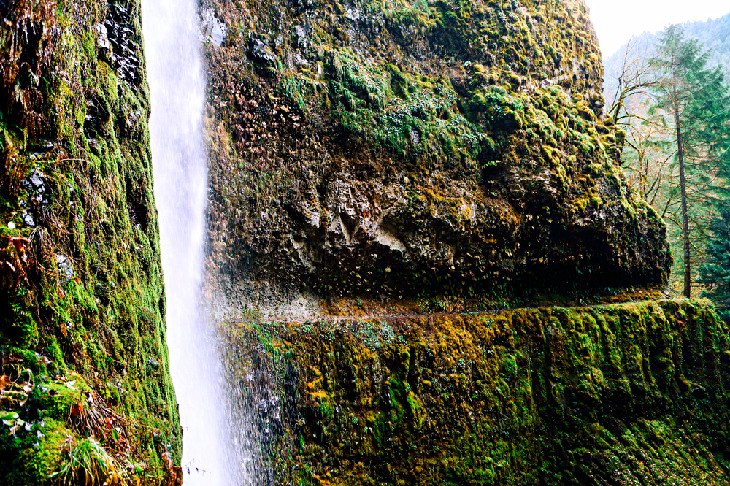
Among the many awesome hikes in the Columbia River Gorge separating Oregon and Washington, Eagle Creek stands above the rest. Alongside lush Pacific Northwest greenery, the route features two stunning and strikingly different waterfalls.
From the trailhead and popular parking area, the trail climbs steadily for two miles before reaching the standout Punch Bowl Falls - one of the best waterfalls in Oregon. This plunging attraction offers a great swimming hole and turnaround point for an easy family hike. And for those looking to go the distance, the trail continues past Punch Bowl Falls to explore farther along a steep canyon.
Nearly four miles past Punch Bowl Falls, and six miles from the trailhead, hikers encounter and go behind Tunnel Falls, a stunning waterfall where the trail has been blasted through the canyon wall. Edges along the canyon trail are without guardrails, and appropriate caution should be applied.
For a continued adventure, the Eagle Creek Trail connects to the cross-country Pacific Crest Trail at just over 13 miles from the trailhead. The 2017 Eagle Creek Fire significantly impacted trail conditions. The official Forest Service website offers current conditions of Eagle Creek and the Columbia River Gorge.
Misery Ridge, Smith Rock State Park
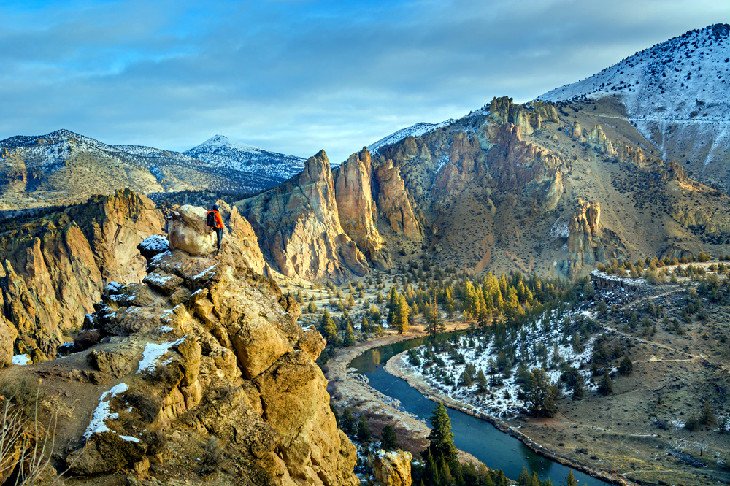
Thirty minutes north of Bend, in the high desert of central Oregon, Smith Rock State Park stands proudly as one of the premier sport climbing destinations in America. Over 1,000 bolted routes adorn the volcanic welded tuff cliffs and basalt columns that define this inspiring landscape, often dotted by relatively small climbers making their way up the face.
Smith Rock is a popular weekend getaway from Portland and provides many other adventure and recreation opportunities outside of climbing. The Misery Ridge hike at Smith Rock takes in the entire landscape with the help of a few switchbacks and is one of the most popular hiking trails near Bend.
The trail ascends steeply for nearly three-quarters of a mile from the Crooked River Bridge before reaching the summit. Here, the trail exposes a great view of the elevated landscape and river valley immediately below.
The trail continues along the ridge until reaching the iconic Monkey Face rock feature, a 350-foot spire and centerpiece of the state park. From Monkey Face, hikers can turn around and head back the way they came or descend the Mesa Verde Trail to connect with the River Trail for a flat finish on a 3.7-mile loop.
Bagby Hot Springs Trail

For a spot to soak some muscles at the end of a hike, the 1.5-mile trail leading to Bagby Hot Springs invites visitors to stay awhile. The trail follows a tributary of the Clackamas River deep within the Mount Hood National Forest, gently rolling through an old-growth forest as it makes its way to the hot springs.
The dense surroundings add a nice appeal to the adventure, but the real reason to visit is the collection of soaking spots at the trail's end.
The most sought-after hot water is within five private stalls complete with hand-hewn cedar log tubs. Community tubs are also available. The hot springs are day-use only, and no nudity is allowed. As well as being one of the best hot springs in Oregon, Bagby is also one of the most popular, too.
Angel's Rest Trail, Columbia River Gorge
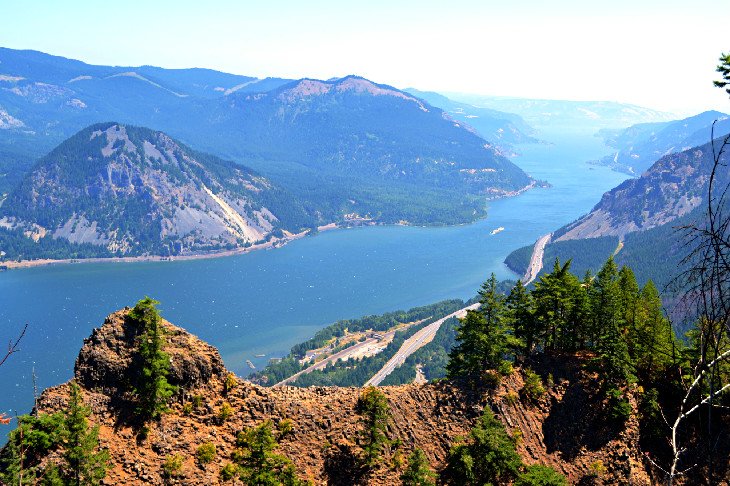
The Columbia River Gorge is well known for waterfalls, and its defining steep terrain also leads to some excellent hiking trails that come with a view. One of the most scenic elevated landscapes is on the rocky outcropping high above the river known as Angel's Rest.
Angel's Rest is accessible by a 2.5-mile trail with a moderately steep grade the entire way. The trail gains nearly 1,500 feet of elevation on the way up, making this relatively short hike still a challenge for new and experienced hikers alike.
The distant views of the Columbia River Gorge from Angel's Rest, stretching for miles in either direction, are well worth the effort. The rocky outcropping is a great place to rest before heading back down the same steep path to the trailhead.
McKenzie River Trail, Willamette National Forest
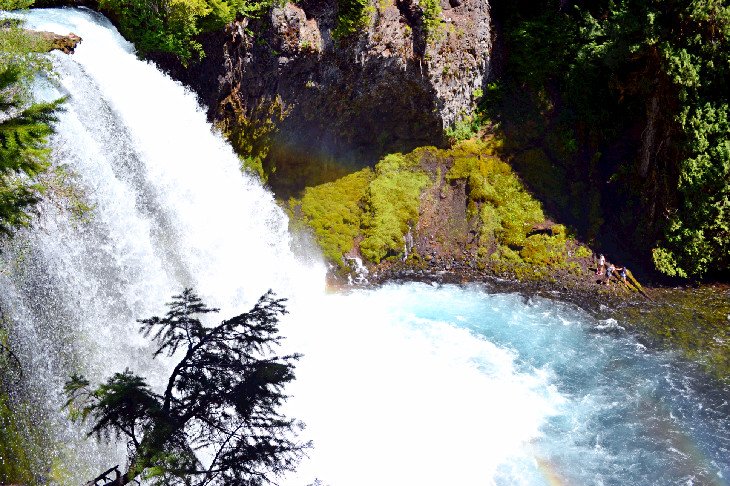
Between Bend and Eugene, this National Recreation Trail follows its namesake waterway for 26.4 miles, revealing a rich environment the entire way. The trail is popular for overnight backpacking trips and sectional day hiking. From north to south, the route follows a primarily downhill grade punctuated by rough and rocky sections with plenty of views.
A major trailside highlight includes both Koosah and Sahalie Falls, two waterfalls that rival each other in splash and scenic attraction.
Another popular destination, the Tamolitch Blue Pool, is a cold source of stunning turquoise beauty popular with hikers, cyclists, and photographers. Most hikers plan for at least three days to hike the entire trail.
Paulina Lake Trail, Newberry National Volcanic Monument
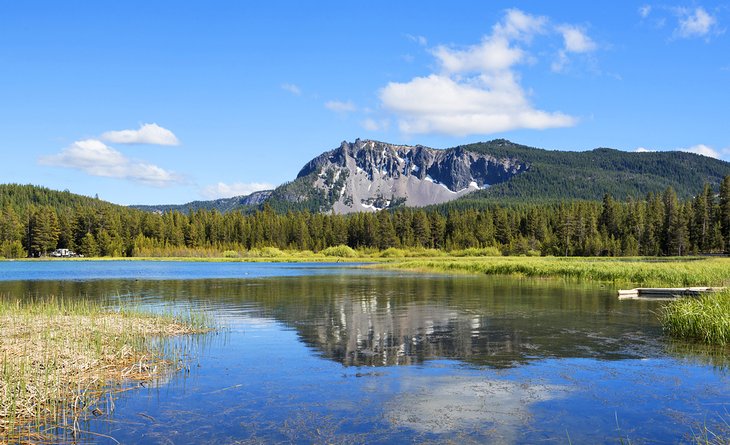
Newberry National Volcanic Monument is within Deschutes National Forest of Central Oregon. It highlights the Lava Lands of the region in spectacular fashion, encompassing over 54,000 acres of rugged terrain. Among the many landscapes to explore are caldera lakes; mile-long lava tubes; and stunning Cascade Peaks, including the monument's tallest, Paulina Peak.
Hiking trails abound throughout Newberry National Volcanic Monument, above ground and below. The 7.8-mile trail circling Paulina Lake isn't the most popular, but it leads to one of the monument's most relaxing features. And while hiking the entire route is rewarding, with views the entire way, most aim for the lake's scenic shoreline hot springs.
It's approximately a 1.2-mile hike to the Paulina Lake Hot Springs, departing from a discreet trailhead in the Little Crater Campground. Make this shoreline and sometimes scrambly hike and keep an eye out for the makeshift soaking spots dug out of the shore. These hand-scooped basins fill with thermal water from below and the wake of the lake, offering a pleasant soak.
Timberline Trail
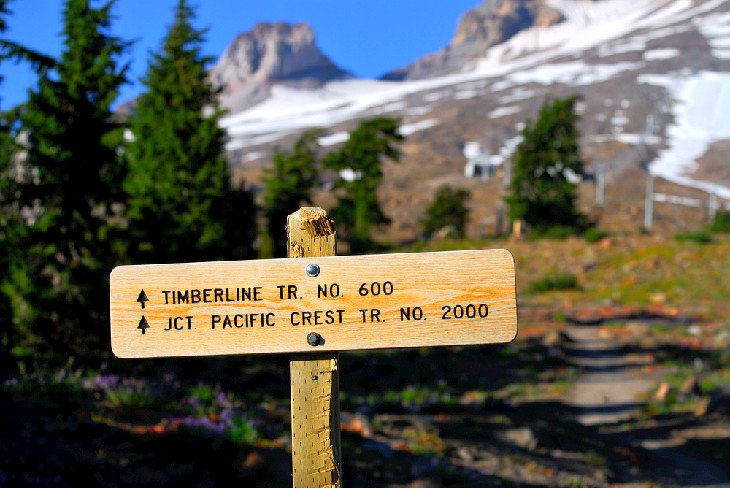
The Timberline Trail circumnavigates the tallest mountain in Oregon and provides multiple perspectives of the stratovolcano known as Mount Hood. The trail is a 40-mile loop often accomplished over three to four days. Thanks to snow-prone elevations and dangerous river crossings, the route is best attempted mid to late summer.
The most popular spot to start and end this bucket-list hike is the historic Timberline Lodge. Here, a notable breakfast buffet can make for a nice reward after the hike. The Timberline Lodge also makes for a great basecamp for out-and-back day hike adventures.
The Timberline Trail covers many landscapes that help define the lush surroundings of the Pacific Northwest. Such scenery includes alpine meadows, waterfalls, and the shadow of a stratovolcano. The most challenging aspects of the trail come from river crossings and dramatic elevation gains.
Oregon Coast Trail
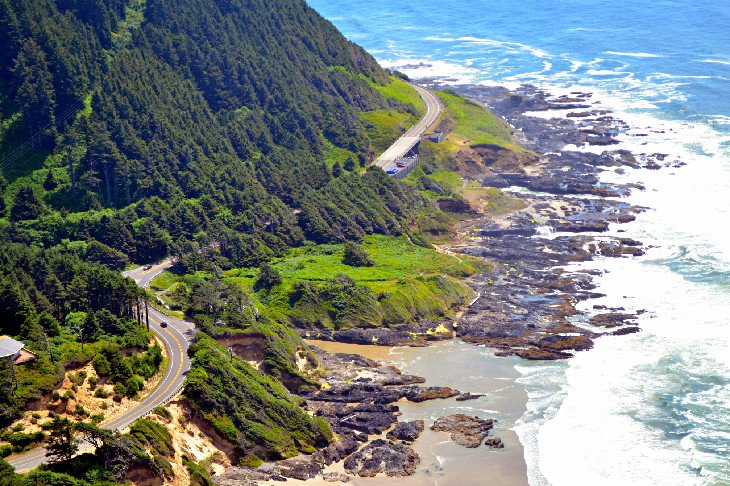
The Oregon Coast Trail spans the entirety of Oregon's open-to-the-public coastline. A few defining features include sandy beaches, forested headlands, and a wide variety of seascapes and sea stacks. While long-distance backpackers often head north to south on this 370-mile, cross-country route, the most popular way to access the Oregon Coast Trail is by day hiking sections at a time.
The forested trek across Tillamook Head offers a popular day trip. Another top day hike on the Oregon coast includes the trail leading up to the viewpoint at Cape Perpetua Scenic Area.
Other popular sections include Haystack Rock in Cannon Beach, the Yaquina Head Lighthouse near Newport, and the Samuel H. Boardman State Scenic Corridor on the southern coast.
Those looking to hike the entire coast, budget at least three weeks to go from end to end. While much of the route follows the beach, plan to trek through various environments, including coastal forests and the occasional road shoulder. Details like camp spots, re-supplies, and transportation across estuaries need to be figured out ahead of time.
Pacific Crest Trail
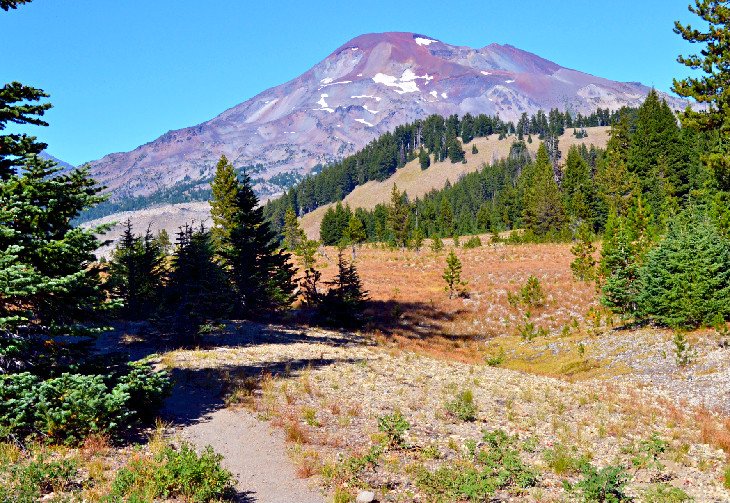
The cross-country, 2,650-mile Pacific Crest Trail (PCT) stretches from Mexico to Canada, navigating much of the elevated terrain that defines California, Oregon, and Washington. Hiking the entire route generally takes the snow-free season of April through October to complete, and thousands of hikers attempt a northbound journey each year.
A "thru-hike" is far from the only way to enjoy this cross-country trail, however. Among the many great day hikes on the Pacific Crest Trail, certain Oregon sections of the trail deserve a much slower pace than what's required to make it to Canada before winter.
From south to north, one of the first major attractions on the Oregon PCT is Crater Lake, where an optional (and highly recommended) alternative route navigates the west rim of the ancient caldera, passing by Discovery Point.
Other major attractions on the Oregon PCT come within the Willamette Valley up north. These landscapes include dramatic lava fields, pristine wilderness settings, and active stratovolcanoes such as Three Sisters and Mount Hood. Exiting out of Oregon and into Washington, the PCT loses significant elevation as it connects with the Eagle Creek Trail and eventually hits the sea-level Columbia River.
Map of Hiking Trails in Oregon
More Related Articles on PlanetWare.com
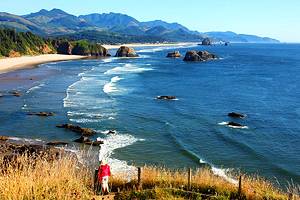
Oregon Coast Adventures: The top attractions of the Oregon coast are ripe for adventure, and home to beautiful beaches. For overnight exploration of the coast, plenty of great campgrounds and resorts can have you sleeping to the sound of the rolling surf. In between exploring the natural wonders of the Pacific Ocean, be sure to take the time to discover some of the best small towns on the Oregon coast.


